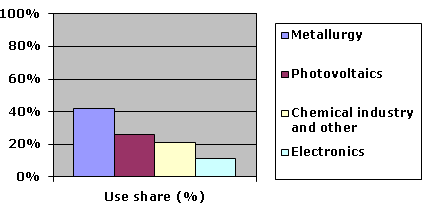The major uses for tellurium include metallurgy to make metal alloys with a view of increasing their machineability; the electronics industry to produce photosensitive semiconductors; photovoltaic to manufacture CdTe solar cells; chemical applications, where tellurium is used as a vulcanizing agent and accelerator in rubber production, as well as a catalyst in synthetic fiber production and oil refining.

Tellurium: major uses
Tellurium could be hardly viewed as a strategic commodity, though its applications in metal alloying and solar cells are promising and future-oriented, while some companies consider this metalloid of strategic importance. However, tellurium is not traded via any major commodity exchange. It could be substituted in most of its uses, which are also limited, though with some losses in technological efficiency and product specifications.
Exact tellurium production numbers are difficult to assess as companies prefer not to disclose the data. Global tellurium production is estimated between 200 to 300 tons. Major tellurium-manufacturing countries are Japan, Russia and Canada, while the largest tellurium reserves are located in Peru, the USA and Canada.
Unstable demand and staggering prices have been blemishing the tellurium market for years. Apart from that, solvent extraction and electrowinning tellurium-free processes for copper recovery are gaining momentum, thus limiting the future of tellurium. The limits of tellurium supply, if any exist, will not provide bottlenecks for the market as the demand for tellurium is unlikely to grow to such an extent.
According to some opinions, more-than-adequate amounts of tellurium are extracted to meet the demand for several years to come, for instance, in the photovoltaic industry. Thus, producers of tellurium-containing products, like photovoltaic cells, are fairly protected from price hikes as the demand for tellurium is unlikely to grow fast, while the supply of tellurium is not constrained. It is predicted that the market for tellurium might grow, but the pace of this growth will not be robust, while instability of the tellurium market may prevent it from providing healthy margins, steadily rising prices and strong demand. However, the situation may abruptly change if either new application niches for tellurium are discovered or the old ones are invigorated, pushing the demand for tellurium to well above current production volumes.
More information on the tellurium market can be found in the cutting-edge research study “Tellurium: 2015 World Market Review and Forecast”.
